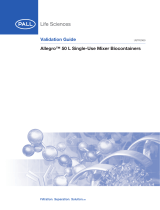
3
Allegro MicroSystems
955 Perimeter Road
Manchester, NH 03103-3353 U.S.A.
www.allegromicro.com
RELATED DOCUMENTATION
Application notes and related information for the ACS37612 is available. Descriptions and locations for related documentation is
listed in the table below.
Table 4: Related Documentation and Application Notes
Documentation Summary Location
ACS37612 Datasheet Product datasheet defining common electrical
characteristics and performance characteristics
https://www.allegromicro.com/en/products/
sense/current-sensor-ics/sip-package-zero-to-
thousand-amp-sensor-ics/acs37612
ACS37612 Purchasing Purchasing homepage https://www.allegromicro.com/en/products/
sense/current-sensor-ics/sip-package-zero-to-
thousand-amp-sensor-ics/acs37612
ACS37612 Gerber Files Schematic files containing evaluation board
layers
https://allegromicro.com/en/products/sense/
current-sensor-ics/sip-package-zero-to-
thousand-amp-sensor-ics/acs37612
ACS37612 Samples Programmer Software Programming software for download https://registration.allegromicro.com/login
ACS37612 Samples Programmer Quick Guide Quick guide documenting the programming
calibration procedure for the ACS37612
TBD
Allegro ACS37612 Busbar Calculator GUI designed to aid in busbar design and
application
https://allegromicro.com/busbar/
Guidelines For Designing a Busbar with Notch
for Allegro’s Coreless ACS37612 Differential
Current Sensor
Application note discussing busbar design and
geometry
https://allegromicro.com/-/media/allegro/
allegromicro/files/application-notes/an296188-
acs37612-guidelines-for-designing-a-busbar-
web.ashx?la=en&hash=0989AAF10F84A4D1D6
571C094D487A13FE4B87A4
An Effective Method for Characterizing
System Bandwidth in Complex Current Sensor
Applications
Application note describing methods used
by Allegro to measure and quantify system
bandwidth
https://allegromicro.com/en/insights-and-
innovations/technical-documents/hall-effect-
sensor-ic-publications/an%20effective%20
method%20for%20characterizing%20
system%20bandwidth-an296169
High-Current Measurement with Allegro Current
Sensor IC and Ferromagnetic Core: Impact of
Eddy Currents
Application note focusing on the effects of
alternating current on current measurement
https://allegromicro.com/en/insights-and-
innovations/technical-documents/hall-effect-
sensor-ic-publications/an296162_a1367_
current-sensor-eddy-current-core
Allegro Hall-Effect Sensor ICs Application note describing Hall-effect principles https://allegromicro.com/en/insights-and-
innovations/technical-documents/hall-effect-
sensor-ic-publications/allegro-hall-effect-sensor-
ics
Hall-Effect Current Sensing in Electric and
Hybrid Vehicles
Application note providing a greater
understanding of hybrid electric vehicles and the
contribution of Hall-effect sensing technology
https://allegromicro.com/en/insights-and-
innovations/technical-documents/hall-effect-
sensor-ic-publications/hall-effect-current-
sensing-in-electric-and-hybrid-vehicles
Hall-Effect Current Sensing in Hybrid Electric
Vehicle (HEV) Applications
Application note providing a greater
understanding of hybrid electric vehicles and the
contribution of Hall-effect sensing technology
https://allegromicro.com/en/insights-
and-innovations/technical-documents/
hall-effect-sensor-ic-publications/hall-effect-
current-sensing-in-hybrid-electric-vehicle-hev-
applications
Achieving Closed-Loop Accuracy in Open-Loop
Current Sensors
Application note regarding current sensor
IC solutions that achieve near closed-loop
accuracy using open-loop topology
https://allegromicro.com/en/insights-and-
innovations/technical-documents/hall-effect-
sensor-ic-publications/achieving%20closed-
loop%20accuracy%20in%20open-loop%20
current%20sensors

























